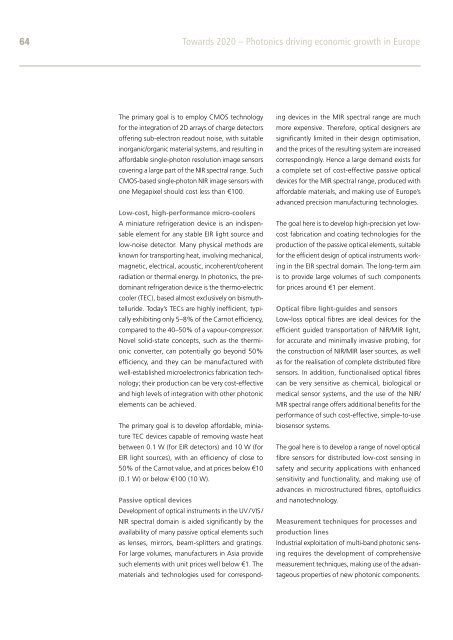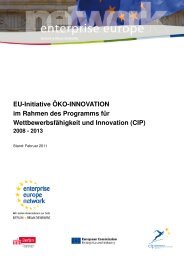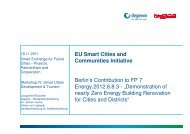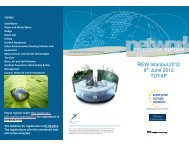Photonics Driving Economic Growth in Europe - Photonics21
Photonics Driving Economic Growth in Europe - Photonics21
Photonics Driving Economic Growth in Europe - Photonics21
You also want an ePaper? Increase the reach of your titles
YUMPU automatically turns print PDFs into web optimized ePapers that Google loves.
64 Towards 2020 – <strong>Photonics</strong> driv<strong>in</strong>g economic growth <strong>in</strong> <strong>Europe</strong><br />
The primary goal is to employ CMOS technology<br />
for the <strong>in</strong>tegration of 2D arrays of charge detectors<br />
offer<strong>in</strong>g sub-electron readout noise, with suitable<br />
<strong>in</strong>organic/organic material systems, and result<strong>in</strong>g <strong>in</strong><br />
affordable s<strong>in</strong>gle-photon resolution image sensors<br />
cover<strong>in</strong>g a large part of the NIR spectral range. Such<br />
CMOS-based s<strong>in</strong>gle-photon NIR image sensors with<br />
one Megapixel should cost less than €100.<br />
Low-cost, high-performance micro-coolers<br />
A m<strong>in</strong>iature refrigeration device is an <strong>in</strong>dispen-<br />
sable element for any stable EIR light source and<br />
low-noise detector. Many physical methods are<br />
known for transport<strong>in</strong>g heat, <strong>in</strong>volv<strong>in</strong>g mechanical,<br />
magnetic, electrical, acoustic, <strong>in</strong>coherent/coherent<br />
radiation or thermal energy. In photonics, the pre-<br />
dom<strong>in</strong>ant refrigeration device is the thermo-electric<br />
cooler (TEC), based almost exclusively on bismuth-<br />
telluride. Today’s TECs are highly <strong>in</strong>efficient, typi-<br />
cally exhibit<strong>in</strong>g only 5–8% of the Carnot efficiency,<br />
compared to the 40–50% of a vapour-compressor.<br />
Novel solid-state concepts, such as the thermi-<br />
onic converter, can potentially go beyond 50%<br />
efficiency, and they can be manufactured with<br />
well-established microelectronics fabrication tech-<br />
nology; their production can be very cost-effective<br />
and high levels of <strong>in</strong>tegration with other photonic<br />
elements can be achieved.<br />
The primary goal is to develop affordable, m<strong>in</strong>iature<br />
TEC devices capable of remov<strong>in</strong>g waste heat<br />
between 0.1 W (for EIR detectors) and 10 W (for<br />
EIR light sources), with an efficiency of close to<br />
50% of the Carnot value, and at prices below €10<br />
(0.1 W) or below €100 (10 W).<br />
Passive optical devices<br />
Development of optical <strong>in</strong>struments <strong>in</strong> the UV / VIS /<br />
NIR spectral doma<strong>in</strong> is aided significantly by the<br />
availability of many passive optical elements such<br />
as lenses, mirrors, beam-splitters and grat<strong>in</strong>gs.<br />
For large volumes, manufacturers <strong>in</strong> Asia provide<br />
such elements with unit prices well below €1. The<br />
materials and technologies used for correspond-<br />
<strong>in</strong>g devices <strong>in</strong> the MIR spectral range are much<br />
more expensive. Therefore, optical designers are<br />
significantly limited <strong>in</strong> their design optimisation,<br />
and the prices of the result<strong>in</strong>g system are <strong>in</strong>creased<br />
correspond<strong>in</strong>gly. Hence a large demand exists for<br />
a complete set of cost-effective passive optical<br />
devices for the MIR spectral range, produced with<br />
affordable materials, and mak<strong>in</strong>g use of <strong>Europe</strong>’s<br />
advanced precision manufactur<strong>in</strong>g technologies.<br />
The goal here is to develop high-precision yet lowcost<br />
fabrication and coat<strong>in</strong>g technologies for the<br />
production of the passive optical elements, suitable<br />
for the efficient design of optical <strong>in</strong>struments work<strong>in</strong>g<br />
<strong>in</strong> the EIR spectral doma<strong>in</strong>. The long-term aim<br />
is to provide large volumes of such components<br />
for prices around €1 per element.<br />
Optical fibre light-guides and sensors<br />
Low-loss optical fibres are ideal devices for the<br />
efficient guided transportation of NIR/MIR light,<br />
for accurate and m<strong>in</strong>imally <strong>in</strong>vasive prob<strong>in</strong>g, for<br />
the con struction of NIR/MIR laser sources, as well<br />
as for the realisation of complete distributed fibre<br />
sensors. In addition, functionalised optical fibres<br />
can be very sensitive as chemical, biological or<br />
medical sensor systems, and the use of the NIR/<br />
MIR spectral range offers additional benefits for the<br />
performance of such cost-effective, simple-to-use<br />
biosensor systems.<br />
The goal here is to develop a range of novel optical<br />
fibre sensors for distributed low-cost sens<strong>in</strong>g <strong>in</strong><br />
safety and security applications with enhanced<br />
sensitivity and functionality, and mak<strong>in</strong>g use of<br />
advances <strong>in</strong> microstructured fibres, optofluidics<br />
and nanotechnology.<br />
Measurement techniques for processes and<br />
production l<strong>in</strong>es<br />
Industrial exploitation of multi-band photonic sens<strong>in</strong>g<br />
requires the development of comprehensive<br />
measurement techniques, mak<strong>in</strong>g use of the advantageous<br />
properties of new photonic components.
















